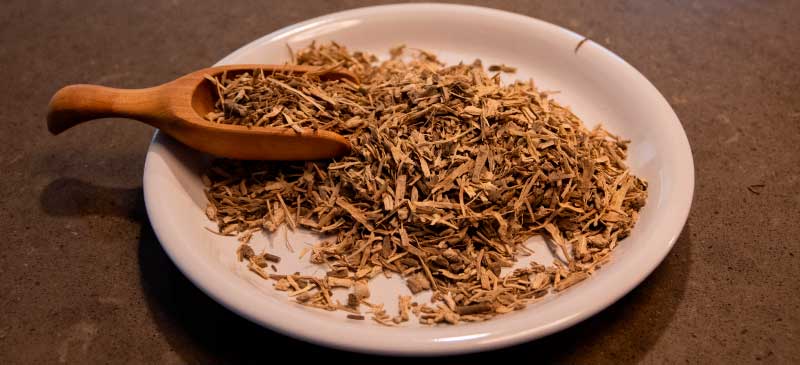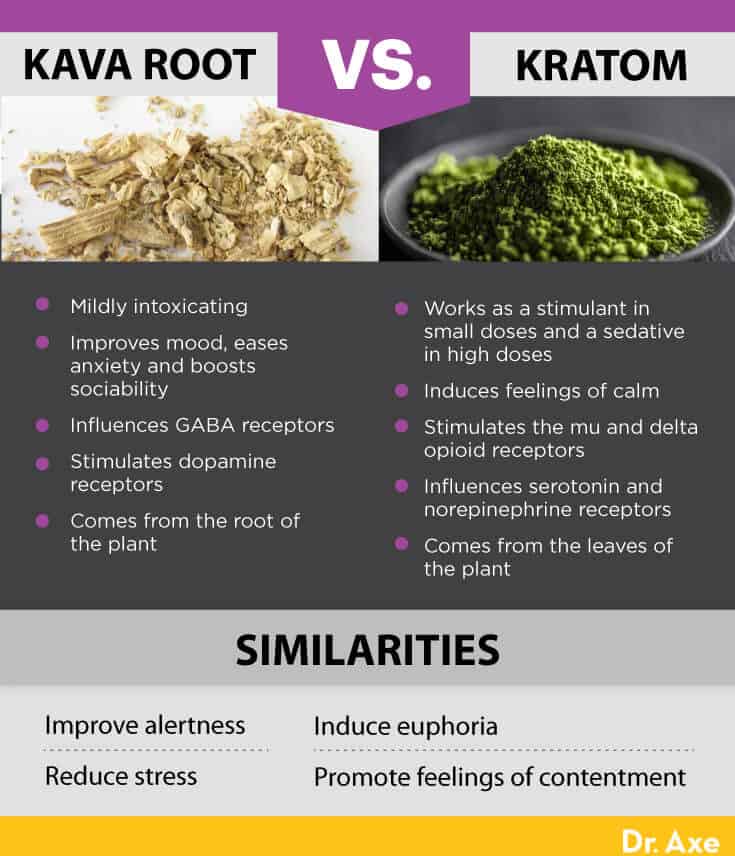
If there was a natural substance that could fight deadly cancer cells yet comes with some potentially harmful side effects, would you want to learn more about it? Chances are you would, and that’s why you should know about kava.
Kava root is most commonly used to calm anxiety, stress, restlessness and treat insomnia, among many others. With so many uses, it’s confusing as to why this herbal remedy has become known as a less than desirable treatment. Let’s find out more about this controversial, medicinal plant.
What Is Kava?
Kava, kava root or kava kava (Piper methysticum: Latin “pepper” + Latinized Greek “intoxicating”) is an herbal plant and crop of the Pacific islands. Kava is consumed throughout the Pacific Ocean cultures of Polynesia, including Hawaii, Vanuatu, Melanesia and some parts of Micronesia. For centuries, kava root has been used as medicine as well as a recreational and ceremonial drink in Oceania.
The name kava is from Tongan and Marquesan cultures; other names for kava include ‘awa (Hawaiʻi), ava (Samoa), yaqona (Fiji), sakau (Pohnpei), and malok or malogu (parts of Vanuatu).
Belonging to the pepper family, it’s also known as asava pepper or intoxicating pepper. The shrub grows to an average height of six feet and has large, heart-shaped leaves that can grow to 10 inches wide.
Ad

The chemical compounds found in kava root are often used to create a drink and are believed to have sedative anesthetic, entheogenic, anxiolytic, analgesic, muscle-relaxing and anticonvulsant effects, mediated by effects on the limbic system, the part of the brain linked to emotions. Kava can also be found in many forms from tablets to powders and teas and remains available at nutrition stores and online.
Its active ingredients are called kavalactones, which have effects similar to alcohol, such as relaxation, talkativeness and euphoria, while reportedly maintaining mental clarity. For these reasons, kava has been proposed to be anxiolytic and used in patients with anxiety disorders and as treatment for insomnia, premenstrual syndrome and stress.
Given these characteristics, it’s no surprise that kava may have an abuse potential. However, it’s rare with conventional doses. Recently, there have been many concerns regarding the safety of kava products due to reports of the effects on the liver and some deaths. The use of kava has been banned or restricted in many countries, such as Germany, Switzerland, France, Canada and Great Britain, though the ban may have been lifted in some of these areas.
While kave has been touted as a natural cancer treatment that blocks tumor growth and shows many signs of chemopreventive potential as well as used to help alleviate anxiety, stress and sleep problems, there have been reports of liver disease and damage along with some deaths that may be related to the use of kava root. The U.S. Food and Drug Administration has issued a warning that using kava supplements has been linked to a risk of severe liver damage. Learn the details below.
Common Uses
Kava root is most commonly used to calm anxiety, stress, restlessness and treat insomnia. It’s also used for ADHD symptoms, epilepsy, psychosis, depression, migraines and other headaches, chronic fatigue syndrome, common cold and other respiratory tract infections, tuberculosis, muscle pain, and cancer prevention.
Urinary tract infections (UTIs), pain and swelling of the uterus, venereal disease, menstrual discomfort, and sexual arousal are other uses of kava root. The list continues, with kava root being applied to the skin for skin diseases like leprosy, to promote wound healing, used as a painkiller and to help with eye-related health issues. It’s also used as a mouthwash for canker sores and toothaches.
Potential Health Benefits
1. May Help Fight Cancer
Flavokawains are secondary metabolites found in kava root that may have anticancer properties. Studies compared the toxicity of kava and monitored the results of cellular adaptation in the human hepatocyte cell line.
To test for subsequent resistance to oxidative stress, cells were pretreated, and some results showed significant cell death, giving reason to believe that kava root has potential as a chemopreventive or chemotherapeutic agent.
An animal study published in Oncotarget was conducted demonstrating that elements within the kava plant may inhibit the growth of certain deficient cell lines. Further studies have demonstrated that dietary feeding of the autochthonous transgenic adenocarcinoma of the mouse prostate (TRAMP) with kava inhibited the formation of lesions and prostate adenocarcinomas, reduced the tumor, and completely abolished distant organ metastasis.
The findings suggest that agents found in kava may be a promising inhibitor for targeting degradation in prostate cancer prevention and treatment.
Another animal study focused on kava and breast cancer. Conducted in Malaysia, the study had the intention of understanding how kava root can help regulate and enhance the immune system as well as impede the inflammatory process in breast cancer-challenged mice.
Notably, there was a decrease in the weight and volume of the tumor following kava treatment. Inflammation in the kava-treated mice had reduced levels as well. Overall, these results show that kava root has the potential to not only enhance antitumor immunity, but also prevent the inflammatory process in a cancer-prone microenvironment.
2. Boosts Immune System
Flavokawains extracts have been found to possess potential anti-inflammation properties. One animal study searched for agents that can enhance the functionality of the immune system without disturbing the homeostatic balance while determining the toxicity and immunomodulatory effects of flavokawain A and flavokawain B, agents found in kava root, on Balb/c mice.
Based on the results, all mice were observed normal after the treatment period, and it seemed as though it did not cause any toxicity. Thus, kava root may be an immune system booster for humans in a similar way it is for mice.
3. Reduces Anxiety
Generalized anxiety disorder (GAD) is a chronic and pervasive condition that generates high levels of psychological stress and is typically difficult to treat long term. Some studies claim that kava root is a nonaddictive and a non-hypnotic anxiolytic with the potential to treat anxiety.
Ad

More research has been reported by Cochrane assessing the evidence for or against the effectiveness of kava root extract for working as a natural remedy for anxiety. Twenty-two potentially relevant, double-blind, placebo-controlled RCTs were identified. Twelve trials met the inclusion criteria and were in favor of kava extract as an aid in reducing anxiety.
Few adverse events were reported, and of those reported, they were all mild. This data posited that kava extract might be an effective symptomatic treatment for anxiety.
A review published in the Journal of Alternative and Complementary Medicine, however, noted that the current evidence is not sufficient enough to confirm the effect of kava for GAD treatment beyond placebo.
4. Promotes Better Sleep
Kava first became popular in the 1990s as an herbal remedy for people who suffer from insomnia and have anxiety. We know that sleep is a big problem for about 50 percent of the population at some point in their lifetimes. Plant-based remedies are becoming more and more desired to help treat sleep disorders and general insomnia, including kava root.
In a study conducted at the University of Rochester School of Medicine and Dentistry, six commonly used plant-based sleep therapeutics were investigated to include caffeine, chamomile, cherries, kava kava, L-tryptophan, marijuana and valerian root. Though no spectacular results were reported, kava and kava drinks appeared to provide some sedative effects.

Kava vs. Kratom
While we have learned a lot about kava, kratom is a similar herb with many of the same effects. Kava and kratom are often compared since they both exude feelings of relaxation, but kratom is known more for boosting energy or calming the mind while kava is more known for its intoxicating, euphoric feelings.
Meanwhile, the FDA cautions consumers about both kava and kratom, with kratom labeled as a “drug and chemical of concern.”
READ RELATED: Top 7 Health Benefits of Blueberries
Both grow in Southeastern Asia, and while kava comes from the root of the plant, kratom comes from the leaves and are often made into a tea referred to as kava tea or kratom tea.
Because they have different mechanisms of action, using both together has been found to offer more potent effects, particularly since both:
- Induce euphoria
- Promote feelings of contentment
- Improve alertness
- Reduce stress
Kava Root
- Mildly intoxicating
- Improves mood, eases anxiety and boosts sociability
- Influences GABA receptors
- Stimulates dopamine receptors
- Comes from the root of the plant
Kratom
- Works as a stimulant in small doses and a sedative in high doses
- Induces feelings of calm
- Stimulates the mu and delta opioid receptors
- Influences serotonin and norepinephrine receptors
- Comes from the leaves of the plant
How to Use and Dosage
Kava is usually made into a drink that’s prepared by grinding, grating or pounding the roots of the plant, then soaking the pulp in cold water or coconut milk. Traditionally the root was chewed, spit into a bowl and mixed with coconut milk or water. That practice is no longer the standard, probably for health reasons.
Kava kava is available in dry bulk, powdered or crushed, capsule, tablet, kava tea, and tincture forms. Western consumers have generally been advised to look for standardized extracts of kava kava that have a 70 percent kavalactone content.
On the other hand, a report submitted to the Committee of Safety of Medicines of the United Kingdom in April 2002 indicates that many of the side effects reported in connection with kava kava are due to the high concentration of the herb in commercial standardized extracts.
The report suggests that kava preparations made according to traditional methods are relatively safe. However, it’s likely that controversy over kava kava will continue.
It’s also important to consider dosage. The appropriate dose of kava depends on several factors, such as the user’s age, health and overall condition. Natural products need to be reviewed with your health care provider and pharmacist before using.
Suggested dosage for treatment of non-psychotic anxiety is 105 to 210 milligrams daily for three to four weeks. The most common side effects of kava are headache, dizziness, drowsiness, depression, diarrhea and occasionally dermatologic manifestations. Precautions should be taken.
Researchers state that given its growing popularity in clinical and recreational use, there’s an “urgent need for quality control and quality assurance of kava products, pharmacokinetics, absorption, distribution, metabolism, excretion, and foundational pharmacology.”
Side Effects and Dangers
It’s very important that you take every precaution if choosing to use kava in any form. If you’re pregnant, breastfeeding or using any prescription medication, definitely avoid taking kava and make sure to check with your doctor prior to making any decision about kava. There is concern that it might affect the uterus.
If you have symptoms of depression, kava use may make depression worse. Because kava affects the central nervous system, it might increase the effects of anesthesia and other medications used during and after surgery. If you use kava, you should stop using it at least two weeks before a scheduled surgery.
Drug Abuse
Because kava is known to provide some very deep relaxation benefits, there’s potential for drug abuse, though this problem seems to be low in most areas. Kava is marketed as an herbal anxiolytic in several countries and is consumed recreationally in high doses in many indigenous Pacific and Australian Aboriginal communities.
Viral Resistance
Health care professionals have been given so much literature on herb-drug interactions that it often makes it difficult to separate experimental and potential interactions from those deemed clinically relevant. For example, there is a need for conclusive information to guide pharmacotherapy in HIV/AIDS.
In a review conducted at the University of Mississippi’s School of Pharmacy, the basis for potential interaction of medicinal herbs with specific antiretroviral drugs were presented while several botanicals were discussed regarding relevant interactions in humans.
This research suggests avoidance of many herbal medicines while taking certain antiviral drugs, such as St. John’s wort, black pepper and grapefruit juice, as well as the African potato, ginkgo, ginseng, garlic, goldenseal and kava kava. This is important to know in order to avoid an herb-induced risk that can lead to viral resistance.
Liver Damage
Kava may be unsafe when taken by mouth. Serious illness, including liver damage, has occurred even with short-term use of normal doses. It’s been reported that the use of kava, for as little as one to three months, has resulted in the need for liver transplants and even death. Early symptoms of liver damage include yellowed eyes and skin known as jaundice, fatigue, and dark urine.
It’s wise to acquire frequent liver tests should you decide to take kava. The severity of liver injury ranges from moderate enzyme elevations to to acute liver failure. In most cases, the liver injury subsides within one to three months of discontinuing the herbal product, but there have been reports of liver transplants in some patients.
Meanwhile, another comprehensive study showed that there was little evidence for liver disease in causal relationship to kava use. Instead, herbal hepatotoxicity in a few patients was connected to overdose, prolonged treatment and comedication — “most probably also as a consequence of poor quality of the kava raw material contained in a few kava extracts.”
To reduce these serious hepatotoxic risks in regard to kava use, it’s essential to create kava quality standards. For example, dried kava roots should contain at least 10 percent total kavalactones and 3 percent kavain, according to the American Botanical Council.
May Not Be Safe While Driving
Using kava can make you unable to drive or operate machinery safely. Do not take kava before you plan on driving. Driving-under-the-influence citations have been issued to people driving erratically after drinking large amounts of kava tea.
A study conducted at the University of Auckland’s School of Population Health in New Zealand reviewed the published literature examining the association between kava use and motor vehicle crashes, related injuries or driving performance. However, no studies quantifying the effects of kava while operating a motor vehicle or related injury were located.
Four experimental studies using computer-based driving simulation examined the effects of pharmacological doses of kavalactones on cognitive and visuomotor performance, finding weak evidence of a slowed reaction time. However, one study found the visuomotor performance on driving simulation to be significantly impaired when kava was consumed with alcohol.
Background
Kava was named by the explorer Captain Cook, who chose a name that meant “intoxicating pepper.” While Captain Cook may have named kava, he didn’t discover it. Kava has been used for thousands of years by Pacific Islanders.
Today in the South Pacific, kava is a popular social drink, similar to alcohol in Western societies. It also still has a role in rituals and ceremonies. One study reported that kava drinking is strongly linked to many of the ceremonial, social and cultural obligations that are deeply embedded within the Tongan culture.
The positive uses of kava include medicinal purposes, male bonding, an alternative to alcohol consumption, and reaffirming and establishing relationships among other Tongan men. The men interviewed in the study also stated negative uses of kava, such as the feeling of laziness, feeling of being too tired to go to work or have sexual interaction with their partners, and the fact that it’s very expensive to buy in New Zealand.
However, kava is one of the most important social pillars of Melanesian societies. It’s been used for more than 1,000 years in social gatherings for the preparation of kava drinks with relaxing effects. It was during the colonial period when extract preparations found their way into Western medicinal systems to treat situational anxiety dating back more than 100 years. However, upon publishing a series of case reports of liver toxicity in 1999–2000, major concerns have been noted.
Pacific Islanders consume a kava kava drink at social, ritual and ceremonial functions to promote feelings of relaxation and euphoria, as well as to commemorate marriages, births and deaths.
It’s enjoyed in meetings of village elders, used as an offering to the gods, used to cure illness and to welcome honored guests.
Final Thoughts
- Kava roots benefits include helping fight cancer, boosting immunity, reducing anxiety and promoting better sleep.
- The risks and side effects of kava root include the potential for drug abuse, viral resistance, liver damage and driving impairment.
- The jury is still out on kava root overall, but the benefits, if taken in proper dosage, seem to outweigh the negatives. The key is consuming the appropriate amount and not overdoing it, particularly since it’s been shown to be addictive.
!function(f,b,e,v,n,t,s)
{if(f.fbq)return;n=f.fbq=function(){n.callMethod?
n.callMethod.apply(n,arguments):n.queue.push(arguments)};
if(!f._fbq)f._fbq=n;n.push=n;n.loaded=!0;n.version=’2.0′;
n.queue=[];t=b.createElement(e);t.async=!0;
t.src=v;s=b.getElementsByTagName(e)[0];
s.parentNode.insertBefore(t,s)}(window, document,’script’,
‘
fbq(‘init’, ‘3475171552810057’);
fbq(‘track’, ‘PageView’);



